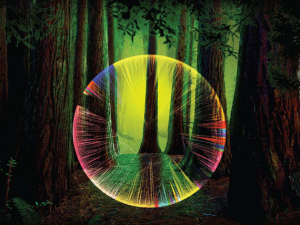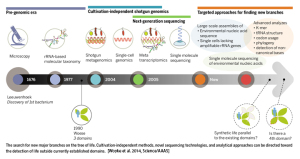Advancing New Tools to Fill in the Microbial Tree of Life

DOE JGI Director Eddy Rubin presented recent work on “microbial dark matter” at the DOE JGI’s 2014 Genomics of Energy & Environment Meeting. Watch his talk at http://bit.ly/JGIUM9Rubin.
(Berkeley Lab-Roy Kaltschmidt)
To paraphrase a famous passage from Coleridge’s “The Rime of the Ancient Mariner”: microbes, microbes everywhere, though most we do not know. This is changing, though.
In a perspective piece published November 6 in the journal Science, Eddy Rubin, Director of the U.S. Department of Energy Joint Genome Institute (DOE JGI), a DOE Office of Science User Facility, along with Microbial Program Head Tanja Woyke, discusses why the time is right to apply genomic technologies to discover new life on Earth. In this perspective they propose the division of microbial life on Earth into three categories: explored, unexplored, and undiscovered. The first can be grown in the laboratory. The second encompasses the uncultivated organisms from environmental samples known only by their molecular signatures. The third, the focus of the perspective, is the yet-undiscovered life that up until now has eluded detection.
“We are poised to discover new life”
“We are poised, armed with a new toolkit of powerful genomic technologies to generate and mine the increasingly large datasets to discover new life that may be strikingly different from those that we catalogued thus far,” said Rubin. “Nature has been tinkering with life for at least three billion years and we now have a new set of ways to look for novel life that have so far eluded discovery.”
“Massive-scale metagenomic sequencing of environmental DNA and RNA samples should, in principle, generate sequence data from any entity for which nucleic acids can be extracted,” Rubin noted. “Analysis of these data to identify outliers to previously defined life represents a powerful means to explore the unknown.”
In addition, Rubin pointed to the advent of single-cell sequencing with microfluidic and cell sorting approaches, focused specifically on cells that lack genes that match previously identified ones, as another approach in the search for completely novel organisms.“We also need to choose particularly suitable environmental niches so that we are not just looking, ‘under the street lamp’ — at environments that we have already previously studied.”
Rubin suggested targets for the discovery of novel life including extreme, inhospitable and isolated environments that are expected to be preferred niches for early life, potentially sheltered from more modern microbial competitors. This would include low oxygen subsurface sites with environmental conditions predating the Great Oxidation Event that occurred about 2.3 billion years ago when the atmosphere went from very low to high oxygen concentrations. Support for the idea that isolated low-oxygen environments may be preferred niches for early life comes from observations that anaerobic niches deep within Earth’s crust tend to harbor ancient branches within the domains of life.
Is there a fourth domain of life?

DOE Joint Genome Institute researchers are illuminating new branches of the tree of life by characterizing novel microbes sourced from extreme, inhospitable and isolated environments, which they expect to be preferred niches for early life, potentially sheltered from more modern microbial competitors. (Berkeley Lab-Zosia Rostomian)
Among the thousands of environmental sequencing targets that make up the DOE JGI’s compendium of genome projects, some mirror the challenges that the Ancient Mariner encountered along the ship’s voyage: “driven by storms to the cold Country towards the South Pole; to the tropical Latitude of the Great Pacific Ocean; and of the strange things that befell.”
Exploring the “undiscovered” classification is expected to be a boon for enriching the public data portals, Rubin said. He also noted that lurking among these difficult ones may well be the discovery of a “fourth domain” of life, to which a reasonable mariner, ancient or contemporary, may proclaim, “full speed ahead.”
Rubin presented recent work on “microbial dark matter” at the DOE Joint Genome Institute’s 2014 Genomics of Energy and Environment Meeting that can be viewed at http://bit.ly/JGIUM9Rubin. The DOE JGI’s 10th Annual Meeting will be held March 24-26, 2015 and the list of preliminary speakers can be found here: http://usermeeting.jgi.doe.gov/.
